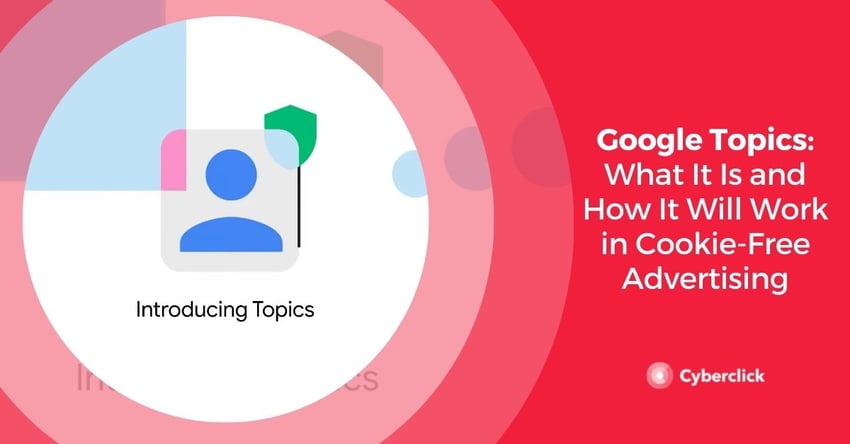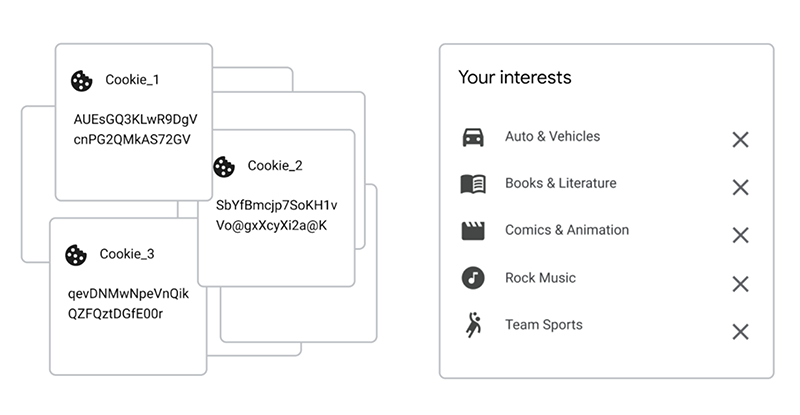Google continues to move towards a cookie-free world while maintaining Google Ads as its main source of revenue. Its first proposal for cookie-free targeted advertising, FLoC, was dropped due to complaints from other industry players. It has since introduced Google Topics, a new solution that intends to be more respectful of users' privacy.
Let's see what it is and how it works.


Goodbye to Cookies and the Privacy Sandbox
In 2020, Google announced that it would eliminate support for third-party cookies in its Google Chrome browser. This was huge in digital advertising, as advertisers had been using cookies for decades to provide users with more targeted and relevant advertising based on their specific interests.
These are the main types of cookies that Google will remove this year:
- Session cookies: these are used to analyze the user's browsing behavior on a website and create profiles with the content they have viewed.
- Tracking cookies: used to create long-term records of multiple visits to the same site in order to analyze user behavior on the site.
- Authentication cookies: these are used to store user credentials, and facilitate log-ins
Google's goal is not to do away with personalized advertising, but to introduce new technologies that offer advertisers features similar to cookies while also being respectful of users' privacy.
As an alternative to cookie-based advertising, Google has launched the Privacy Sandbox project, which aims to reduce the tracking of users while still allowing them to be shown targeted ads based on their characteristics and interests.
Google has announced multiple applications within this project, including aggregated reporting, ad budgeting, and measurement APIs. The most controversial of them is FLoC: Federated learning of Cohorts.
Instead of tracking individual user behavior (as had been the case with cookies), FLoC creates a series of "behavioral groups" from which conclusions can be drawn. However, several industry players, such as the search engine DuckDuckGo and the browser Brave, spoke out against it on the grounds that it still presented privacy concerns.
How Does Google Topics Work?
Topics is Privacy Sandbox's new approach to interest-based advertising. This tool aims to capture the learnings and feedback received from the first FloC tests.
With Google Topics, the user's browser determines a series of topics, such as "Sports" or "Travel" that represent the user's main interests over the last week. This information is deduced from their browsing history.

Topics of interest are selected only on the user's device, without involving any external servers (including Google's). Topics are retained for only three weeks and then deleted. Because they are browser-based, they allow the user to more easily see and control how their data is shared compared to third-party cookies.
When the user visits a website that is part of the Topics ecosystem, three topics (one from each of the previous three weeks) are chosen to be shared with the website and its advertising partners.
On a technical level, first, the API tags each website with a general topic, e.g. "Cooking". Then, the browser collects some of the most frequent topics from the websites the user has visited. The topics are then shared with the sites the user visits to help them display more relevant ads, without needing to know the specific sites the user has visited.
The browser uses a limited list of topics selected from a public, manually created list. The proposed list contains about 350 topics to prevent information about the user from being too detailed.
Google Topics allows browsers to display topic information transparently and give users control. In Chrome, the user can control stored topics, delete topics, or even disable this functionality altogether. In addition, to further protect users' privacy, topics exclude categories such as gender or race.
Google has announced that it will soon launch a Topics test in Chrome that will include user controls and allow web developers and the advertising industry to test this new functionality. The final design of the user controls and other technical aspects will depend on the results of these tests and the feedback received.
The Differences Between Google Topics and Floc
Google's previous proposal to replace cookies, FLoC, used browsing history to group users into groups of thousands of people. One of its most controversial aspects is that it had a large number of categories, as many as 30,000, which meant that companies could have very detailed profiles of users. Topics, on the other hand, is limited to about 350 categories, which means that the information companies receive is much less detailed.
In short, Google Topics seeks to respect users' privacy as much as possible. In the coming months, the results of the first tests will be available and advertisers will be able to assess whether it is a suitable solution for quality targeted advertising.
Graduado en Telecomunicaciones y Doctor en Fotónica por el Instituto de Ciencias Fotónicas. Cuenta con más de 5 años de experiencia trabajando con Google Ads y Google Analytics, gestionando estrategias de SEM y todo tipo de campañas a través del embudo, desde búsqueda hasta Youtube.
Graduated with a degree in telecommunications and holds a PhD in photonics from the Institute of Photonic Sciences. He has more than 5 years of experience working with Google Ads and Google Analytics, managing SEM, and all campaigns type across the funnel from search to Youtube.





Leave your comment and join the conversation